Buckwheat is a versatile ingredient that can be eaten for breakfast or a hearty side dish. It’s filling and delicious, and can be served savory or sweet. Buckwheat kasha is a naturally gluten-free seed that is nutrient rich with high fiber and protein making it a healthy part of your meal.
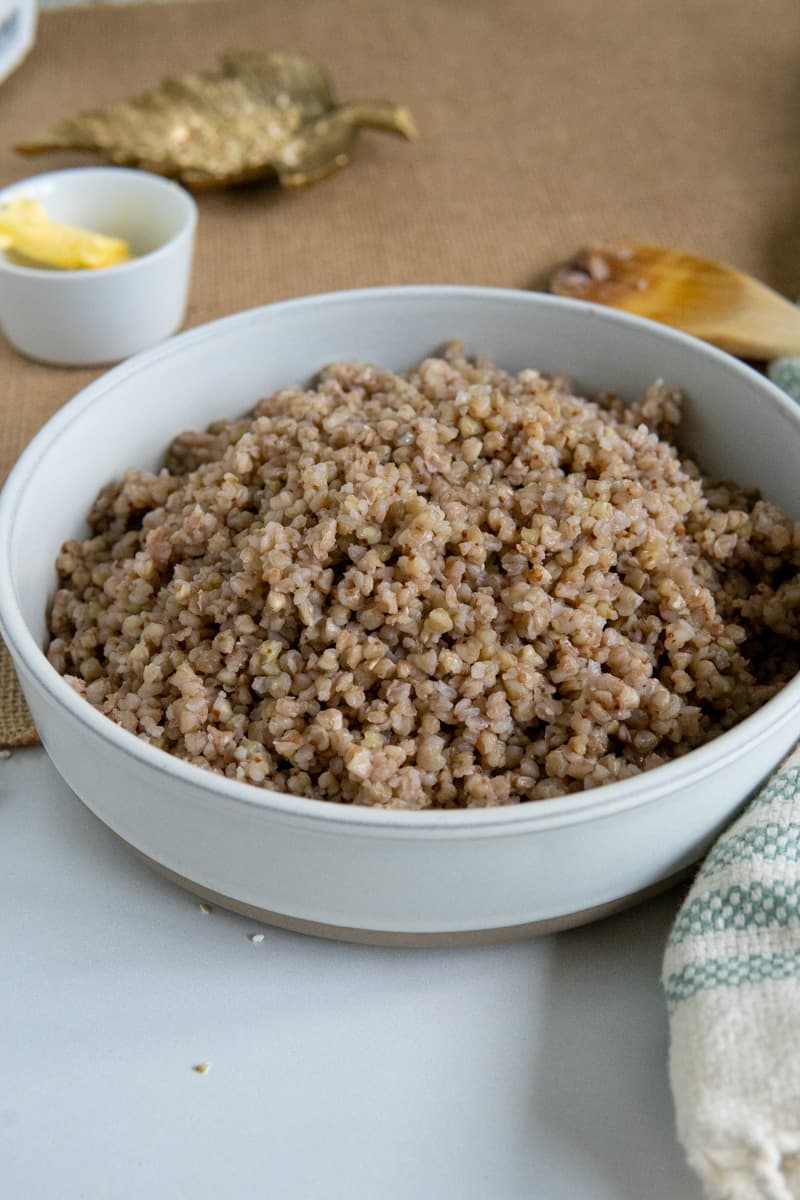
Why trust my recipe?
Although buckwheat has been gaining popularity in the United States as an alternative to gluten containing grains, it still isn’t as well known as other grains.
Buckwheat is very popular in Eastern Europe. Despite growing up in the United States, my family maintained its Ukrainian immigrant roots, and buckwheat remained a staple in our diet. It was one of my mother’s favorites, so it was on constant rotation, in all different forms! Now, I like serving it to my family since it’s an easy, versatile, and nourishing meal. I use it as a side dish or for breakfast.
Jump to:
What is buckwheat?
Despite the name, buckwheat actually does not contain any wheat. Buckwheat is a pseudocereal - a seed that can be eaten like cereal grains, but is not a grain. It is similar to quinoa, another popular pseudocereal. The kernels of buckwheat are called groats.
Buckwheat groats are also sometimes called kasha. In Eastern European and Slavik countries, kasha mostly refers to porridge or an assortment of whole grains like oats, wheat, barley, oats, millet, and rye. In the United States, buckwheat is also referred to as Kasha in Jewish cuisine. This probably originated from Ashkenazi Jewish immigrants. There are popular Jewish dishes called kasha varnishkes or kasha knishes that use this roasted buckwheat grain.
I frequently ate buckwheat growing up in Ukraine, as it is popular in Eastern Europe. When we immigrated to the United States, my mother continued cooking buckwheat and served it as a side dish or breakfast. I love serving it to my family since it is naturally gluten free, and an easy and filling meal.
Buckwheat can be eaten in different forms. The groats can be cooked and eaten in a similar way to oatmeal. They are a great alternative to white rice or quinoa. The groats can be toasted or raw. Groats can be milled into a finer consistency to make buckwheat porridge or even finer into buckwheat flour to make baked goods. You can use the gluten-free flour to make buckwheat pancakes or crepes. They can even be made into buckwheat pasta, called soba noodles!
Buckwheat is a good source of fiber and contains minerals needed for healthy body function. You can read more about the health benefits of buckwheat in the article Buckwheat 101: Nutrition Facts and Health Benefits from Healthline.
Types of Buckwheat
Roasted vs raw buckwheat groats. Raw buckwheat is the untoasted groats, and roasted buckwheat just means the groats have already been toasted. Toasting raw groats will give it a nutty flavor, but it is not necessary. The roasted version of buckwheat is sometimes referred to as kasha. You can use either for this recipe.
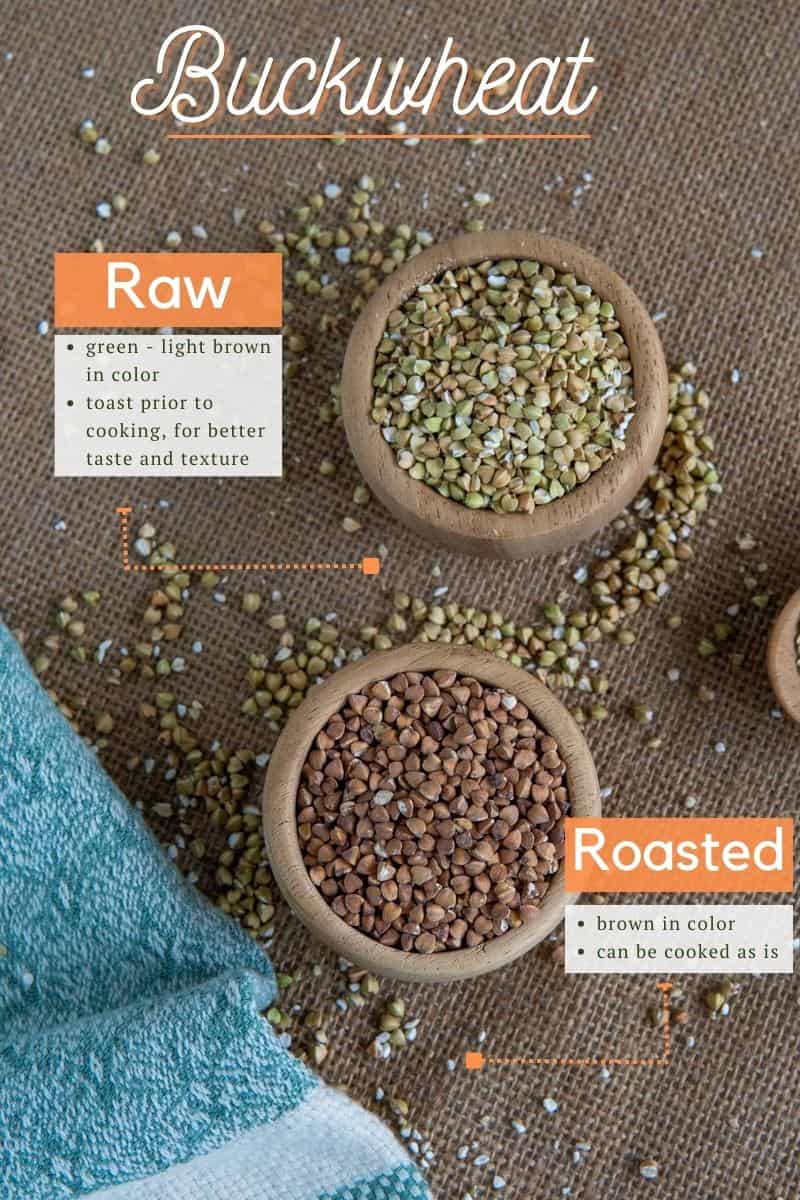
Cream of buckwheat. This is buckwheat that has been milled to a finer texture. When cooked, it creates a porridge-like consistency. It also cooks quicker since the whole groats have been broken down into smaller pieces. This version of buckwheat can be eaten as hot cereal like you would oatmeal.
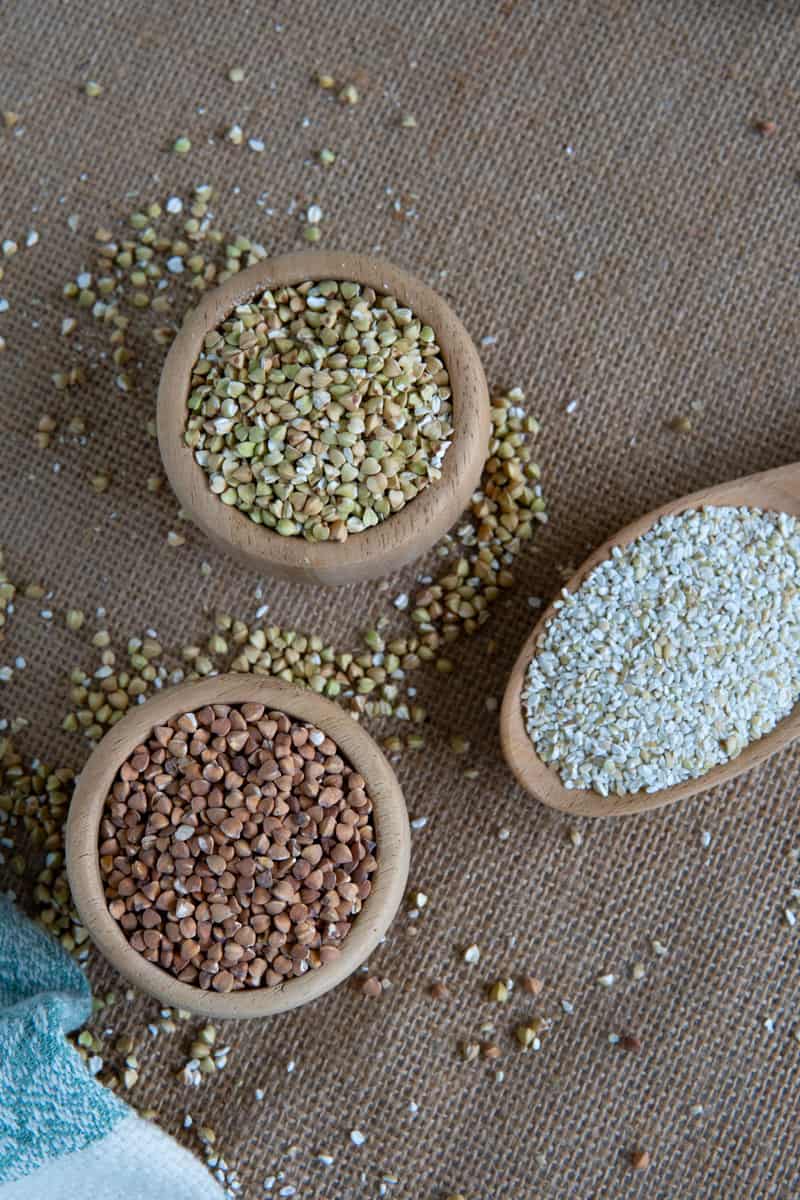
Is Buckwheat Gluten Free?
Buckwheat is a naturally gluten free food! Even though there is “wheat” in the name, buckwheat does not contain any wheat, and therefore is gluten free. This makes it a great grain-like option for those with celiac disease, a non-celiac gluten sensitivity, or following a gluten-free diet.
Always use caution when buying buckwheat products! Some buckwheat is processed in plants that process wheat based products, and cross contamination may occur. You should always read the labels of your buckwheat to be sure if you or your loved ones have a gluten intolerance or allergy.
Which Brands of Buckwheat are Gluten Free and Safe for Nut Allergies?
Even though buckwheat is gluten free, some brands of buckwheat are processed in factories that also process gluten and nut containing products. This can cause an issue with cross-contamination.
The following brands of buckwheat are both gluten free and safe for those with nut or peanut allergies.
- Pocono Cream of Buckwheat
- Bob’s Red Mill Organic Buckwheat Hot Cereal
- Bob’s Red Mill Organic Whole Grain Buckwheat
- Eden Organic Buckwheat is the one I used in this recipe
- Wolff’s Kasha
My daughter, Mika, has a severe peanut allergy, and I feel safe feeding her these brands of buckwheat. As always, double check your packaging for allergens before consuming! There should be certified gluten-free labels on truly gluten free products.
As an Amazon Associate, I earn from qualifying purchases.
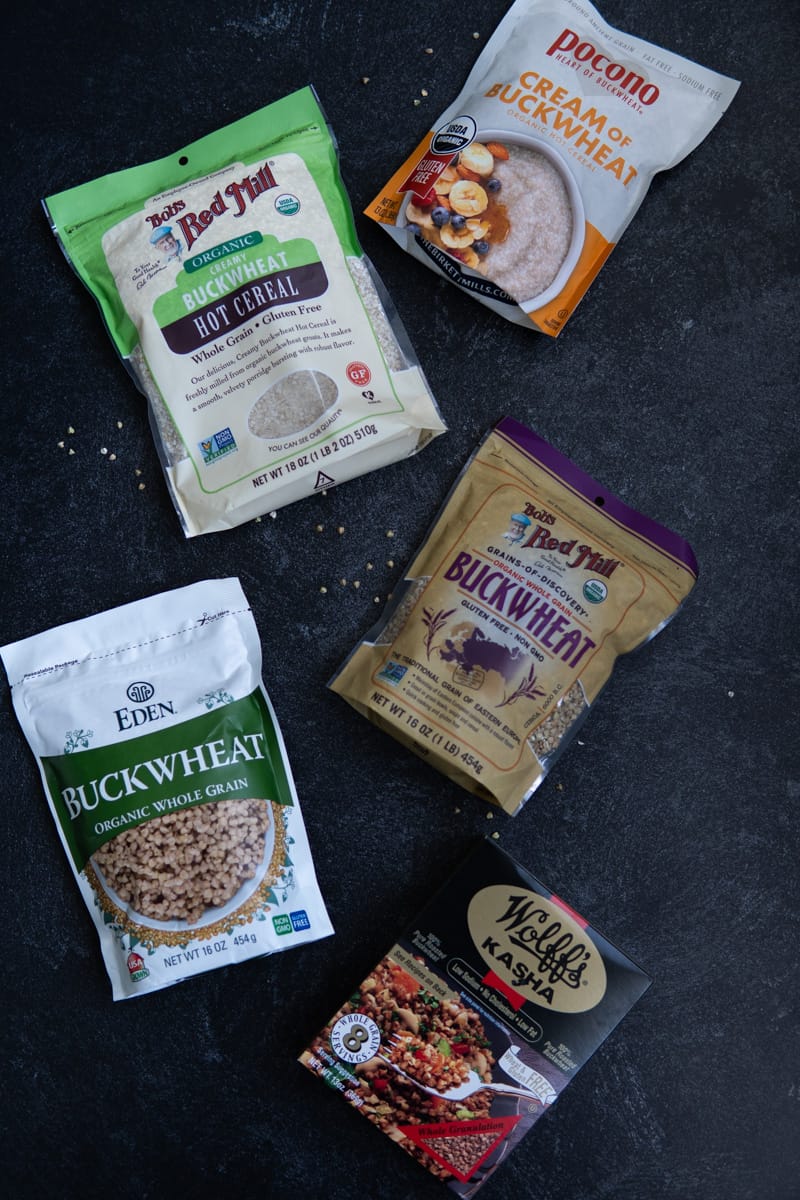
Where to Purchase Buckwheat?
Buckwheat can be purchased at Eastern European specialty stores or Asian markets. It is also sometimes available in regular supermarkets in the kosher section. Health food stores, Whole Foods, and Vitacost all usually carry buckwheat.
I have personally cooked Pocono Cream of Buckwheat, Bob’s Red Mill Organic Buckwheat Hot Cereal, Bob’s Red Mill Organic Whole Grain Buckwheat, Eden Organic Buckwheat and Wolff’s Kasha, and find them all to be good brands.
Many recipes online for buckwheat by Eastern European bloggers recommend a very specific Eastern European bag of buckwheat. The problem with this brand is that it is not easy to purchase, and because it was not processed in the United States, I am unsure of the labeling laws. I can not verify if this brand is processed in a gluten free and nut free factory, and I don’t want to risk any cross contamination!
To avoid that potential problem, I’ve experimented with brands I can purchase at my local grocery stores. The buckwheat brand I found that IS NOT SAFE for all allergies is by Shiloh Farms, as it could have nut cross contamination.
Ingredients Needed to Make Buckwheat
To make this basic buckwheat recipe, you only need a few simple ingredients! You’ll need buckwheat groats (raw or roasted), butter, water, and salt!
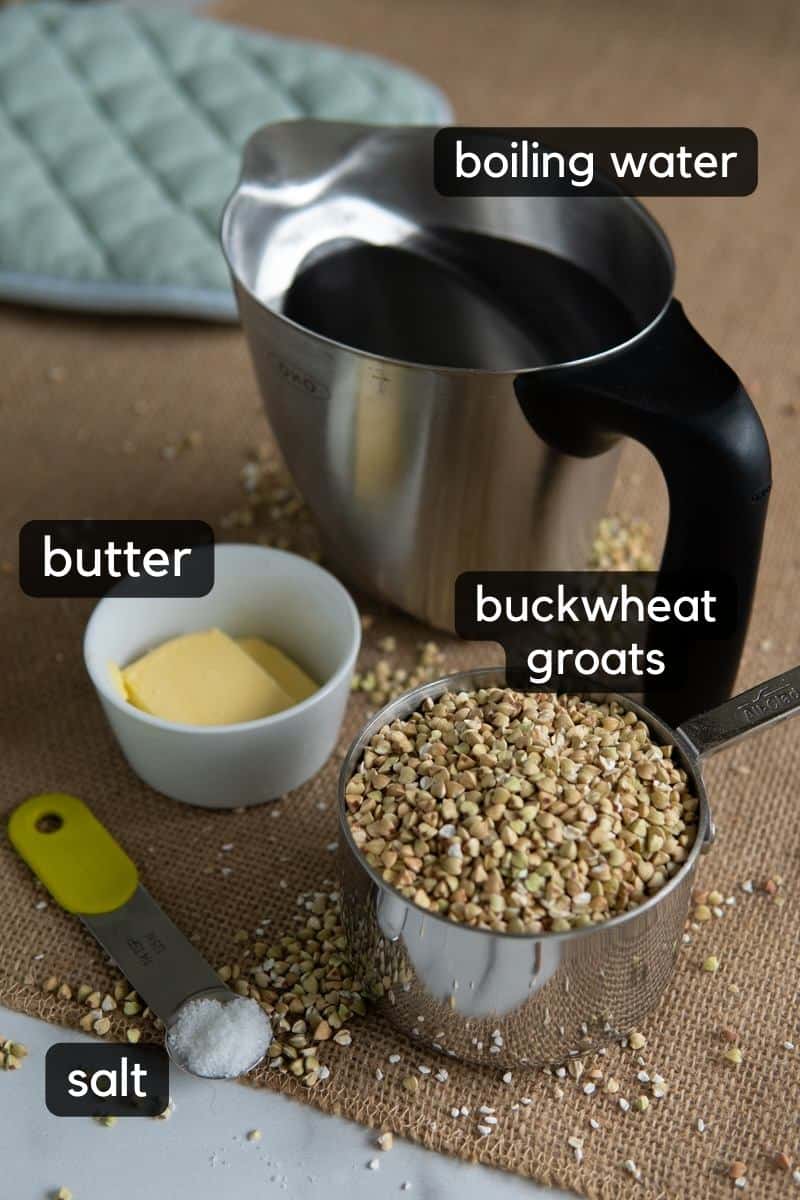
How to Cook Buckwheat
Cooking buckwheat is simple and is ready in under 30 minutes! You can cook buckwheat by different methods, like in a pressure cooker or rice cooker, but I prefer to make it on the stove since it is so easy.
Step 1. Boil water in a tea kettle or in a pot.
Step 2. Rinse buckwheat groats in a fine mesh strainer, under cold water, until the water is clear. Gently shake the strainer to get as much water out as possible.
Step 3. Heat a medium-sized pan over medium heat, then add rinsed and well-drained buckwheat to the pan. Stir with a rubber spatula. Add a tablespoon of butter, and mix with a spatula until the groats are coated. Toast for about 3 to 5 minutes, stirring often.
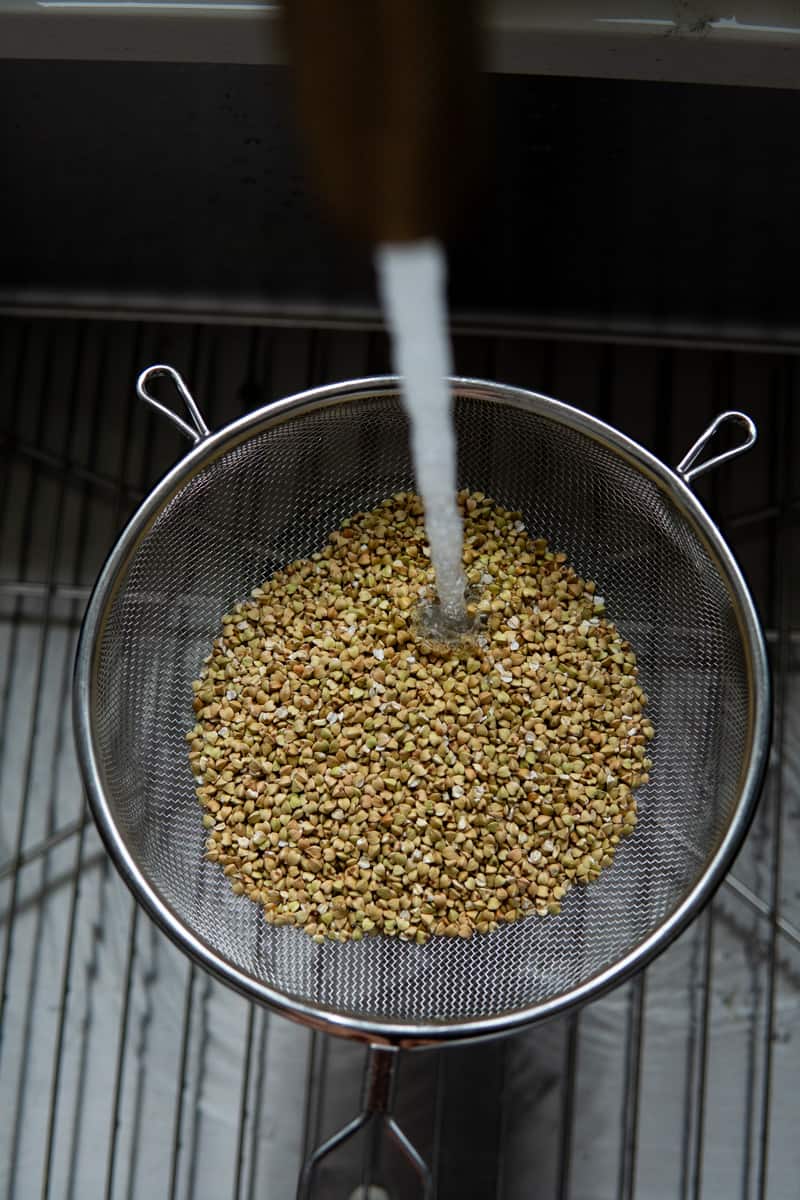
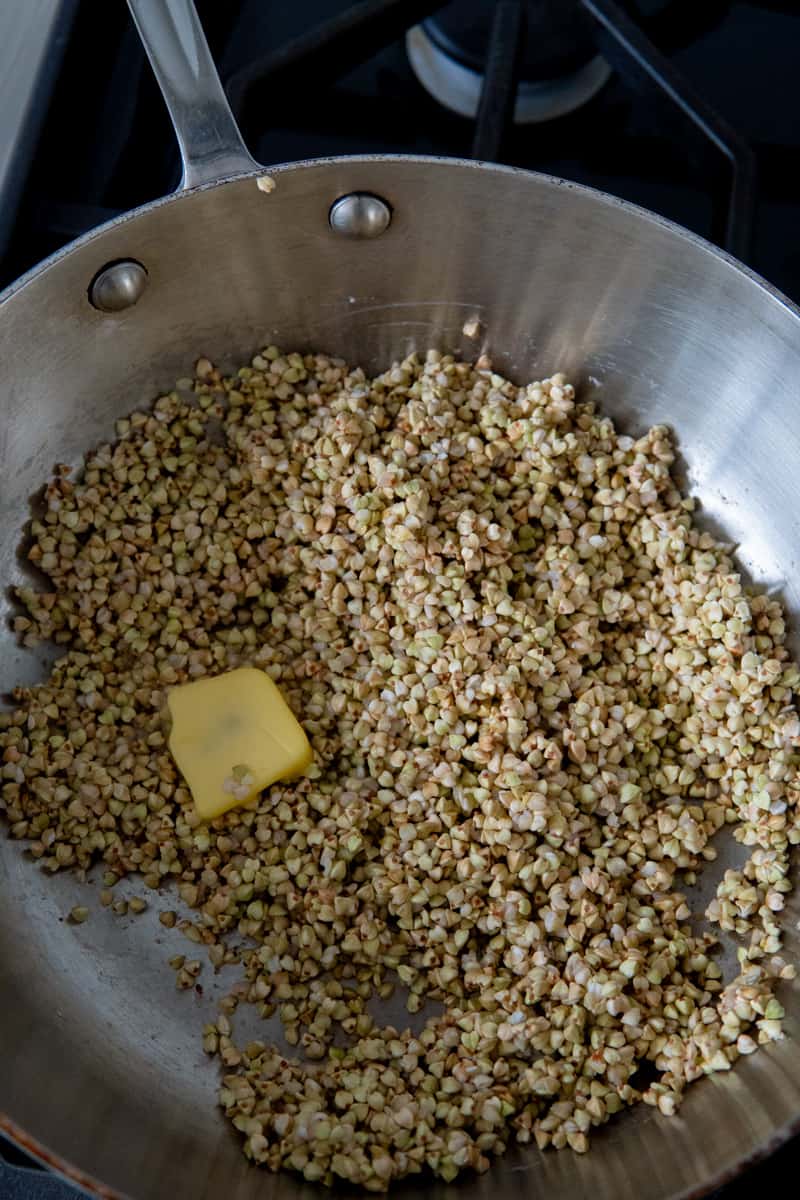
Step 4. When buckwheat groats are golden brown, carefully measure out 2 cups of boiling water and add to the pan. It will sizzle, so be extra careful and go slow when pouring, adding one cup at a time.
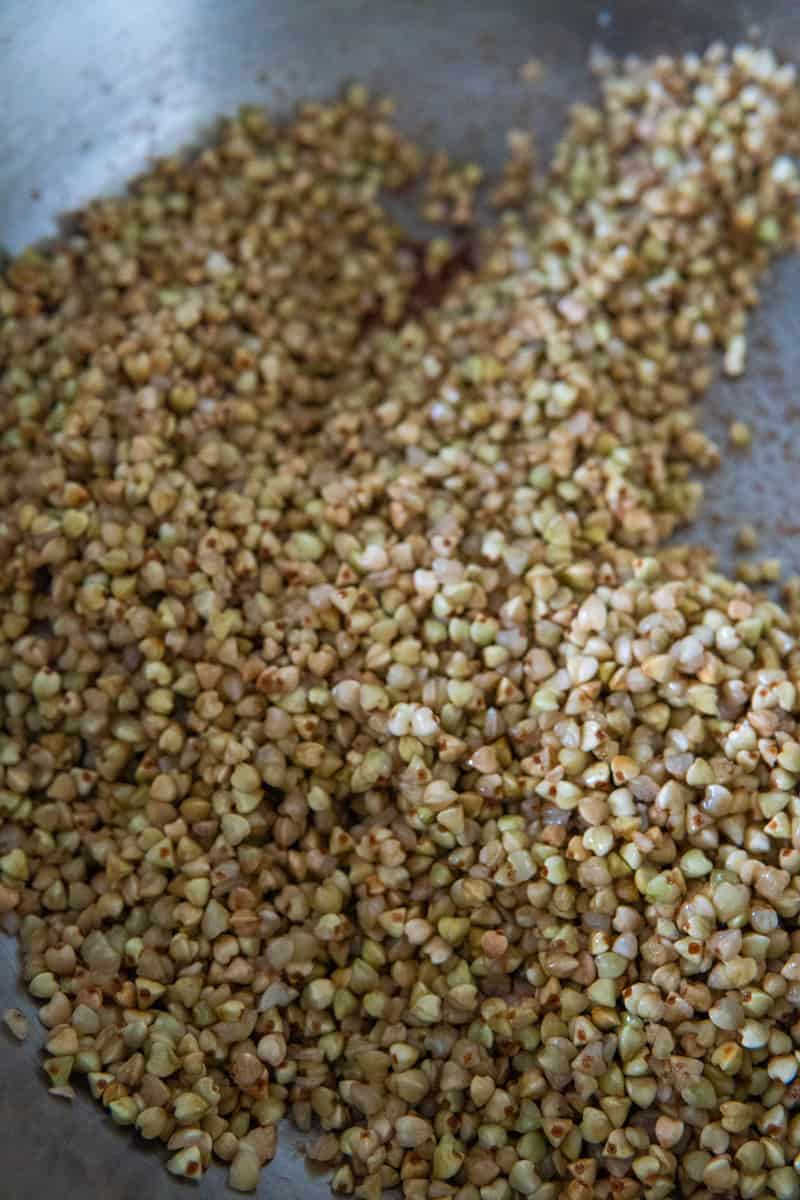
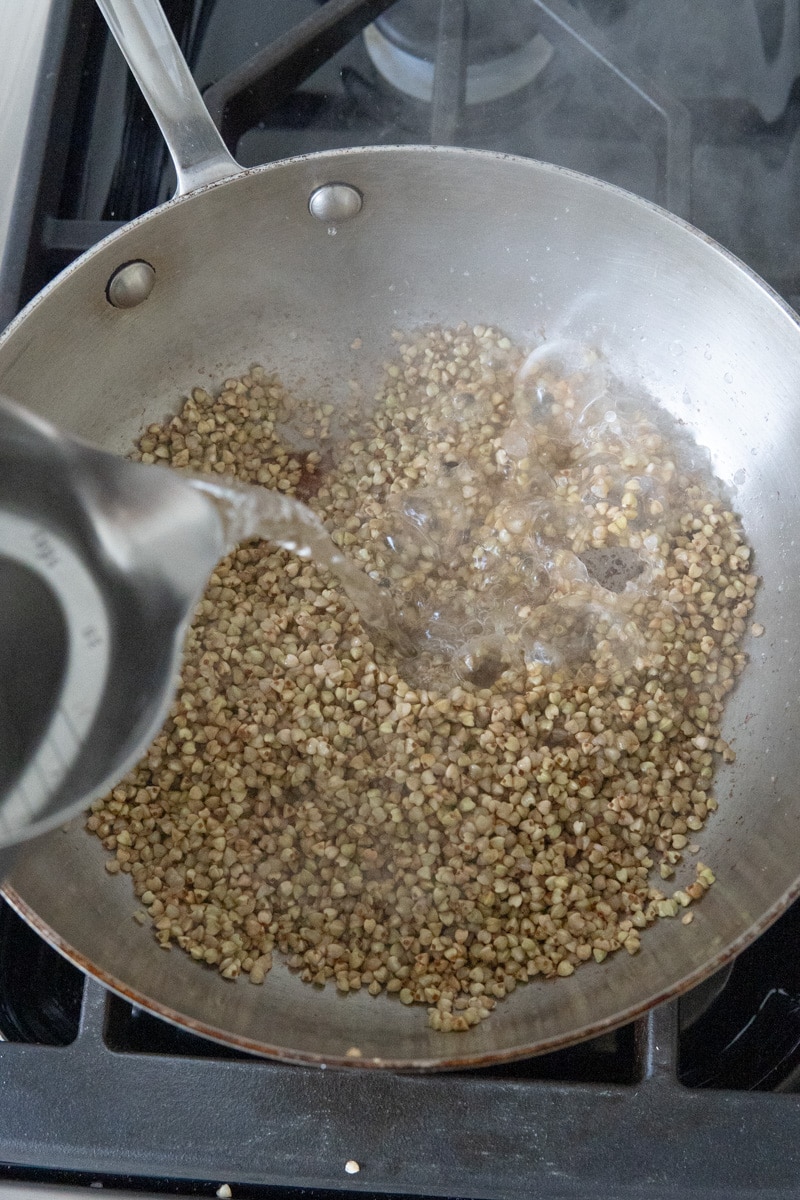
Step 5. Bring it back to a boil, season with salt, then lower the heat to low, close the lid, and cook for about 13 min. Turn off the heat and let it sit for 10 min untouched and without removing the lid.
Step 6. Finally, remove the lid and fluff with a fork. Per preference, you can add ½ to 1 tablespoon of butter and lightly mix it in. You can start with smaller amounts, then add as you like, or leave the butter out completely.
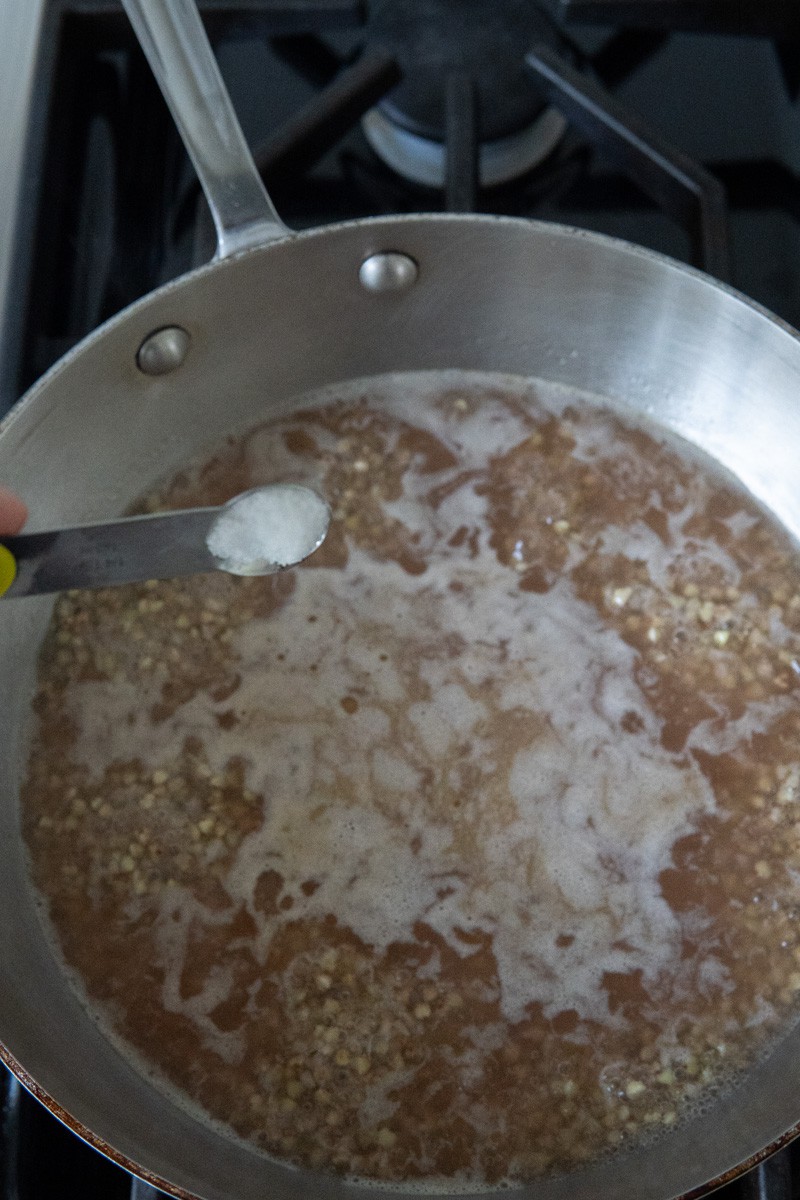
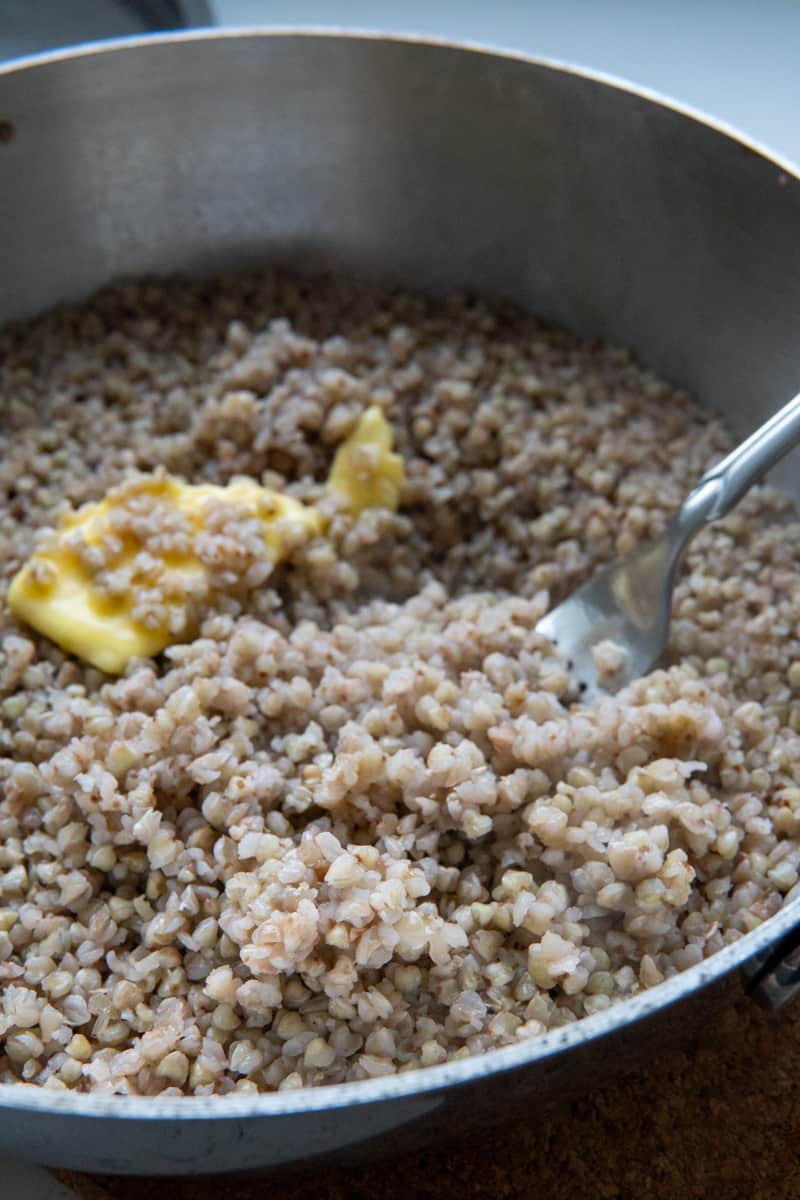
Expert Tips for Cooking Buckwheat
- Use boiling water; be careful when adding it to the pan.
- Rinse the buckwheat well to get rid of any particles and dust. Drain well before toasting.
- You can roast buckwheat in a dry skillet, but I prefer to coat it in butter and toast until golden brown. You can also use olive oil to toast instead of butter for a dairy-free option.
- The best ratio for making buckwheat groats is 1:2 buckwheat to water.
- The best cooking vessel for making buckwheat groats is a stainless steel pot or pan, or a dutch oven. Avoid using a nonstick pan.
- After 10 min of cooking, you can insert a spoon, fork, or spatula to see if there is any liquid at the bottom that hasn't evaporated yet. The kernels should be individual and not mushy.
- When the groats are finished cooking, fluff with a fork, but don’t over-mix.
- Adding additional butter at the end of cooking is optional.
- To prevent mushy buckwheat, make sure you are using the correct buckwheat to water ratio and don’t overcook it.
- Serve the buckwheat hot as a side for savory dishes. Alternatively, use it like porridge or a hot cereal and serve in a bowl with a bit of milk over it. In my home, it’s a popular breakfast dish. You can also add honey, maple syrup, or sugar for some sweetness, or keep it savory!
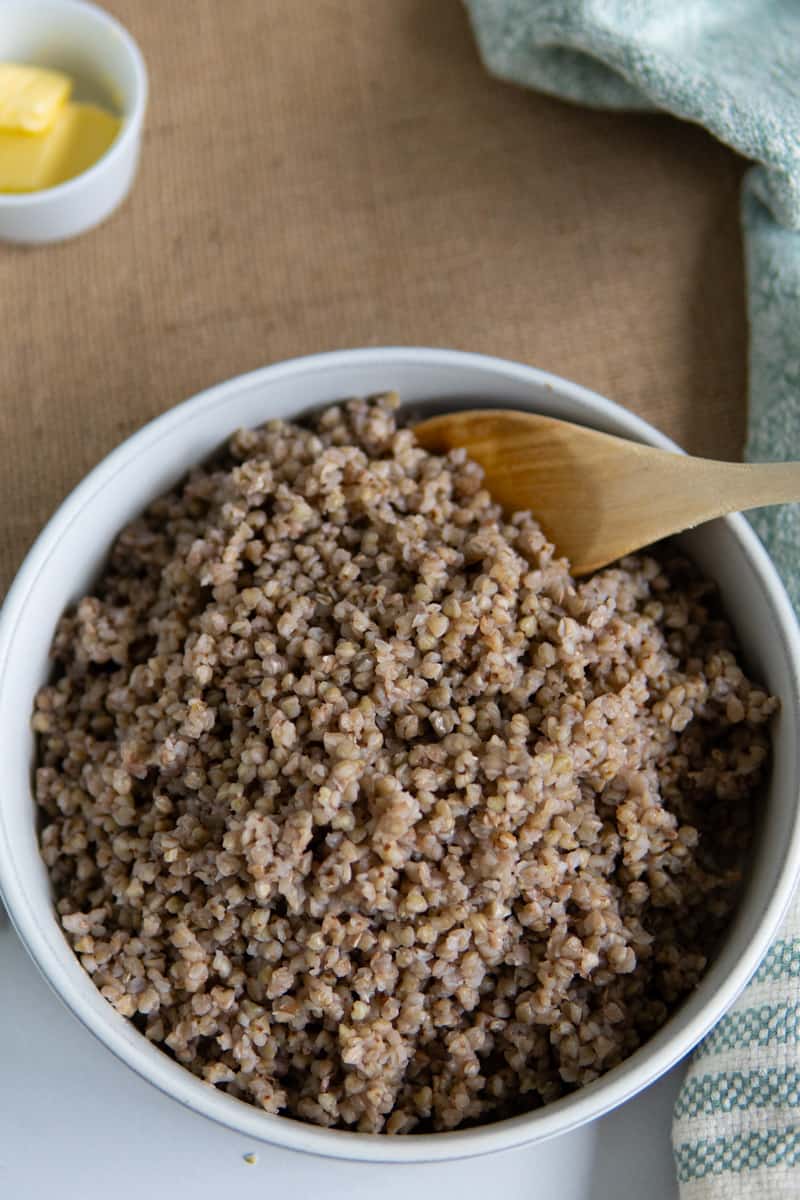
How to Store buckwheat?
- Dry - Store buckwheat in an airtight container or a sealed bag in a pantry or other dark, cool, and dry place.
- Cooked - Once cooked, buckwheat will keep in the refrigerator in an airtight container for several days.
- Freeze - I don’t recommend freezing buckwheat.
- Reheat - To reheat cooked buckwheat groats, microwave covered until warmed or heat it on low heat on the stovetop.
Pairing Suggestions
What goes great with buckwheat? Buckwheat is a versatile food that can be served sweet or savory. It can be served as a side dish or the main course for breakfast.
Here are some ideas for serving buckwheat.
- Pair it with sautéed mushrooms
- Serve it under braised or stew cooked meats
- As a side with roasted veggies like butternut squash
- It’s a great addition to salads like tabbouleh
- Use buckwheat in place of rice or quinoa, like in this Easy Salmon Rice Bowl recipe
- Serve it with Roasted Salmon
- For breakfast, serve it with a runny egg on top
- Toast the groats until crispy and add as a crunchy topping on salads
Here are a few of my favorite dinner dishes to serve with buckwheat groats!
Other Ways to Use Buckwheat
- Use buckwheat noodles (Japanese soba noodles) for a lo mein or stir fry
- Make buckwheat crepes from organic buckwheat flour
- Buckwheat flour can be used in your gluten-free baking to make cookies, crackers, and even brownies
Recipe FAQ
To make perfectly cooked buckwheat, use a 2:1 water to buckwheat ratio. That means 1 cup of buckwheat groats to 2 cups of water.
No, you do not have to soak buckwheat before cooking it.
With toasting and boiling, buckwheat should be ready in under 30 minutes. Using kasha, which is toasted buckwheat, will save you additional time since you do not have to toast the groats.
Buckwheat and kasha are often used interchangeably but are not exactly the same. Kasha sometimes refers to buckwheat groats that have been roasted.
There are a few things to do to prevent mushy buckwheat. Make sure you are using the correct 2:1 water to buckwheat ratio. Don’t overcook the buckwheat, which can lead to a mushy texture. Also, don’t overmix the cooked buckwheat too much.
In conclusion, buckwheat is a naturally gluten free pseudocereal that is becoming more popular with those living a gluten-free lifestyle, but it has been popular in Eastern European and Asian countries for a long time. It has a high fiber content and contains essential nutrients for a healthy diet. Buckwheat can be eaten by those with gluten sensitivities.
This pseudo grain can be processed and prepared in several different ways. Buckwheat groats can be eaten as a breakfast food or side dish. The groats can be milled into a finer consistency or flour to make gluten-free baked goods. It can be used in place of some gluten-containing grains. It's a versatile food that deserves a place in your gluten free pantry! Just make sure to double check your labels that the product you are buying is certified gluten free.
Gluten Free Recipes
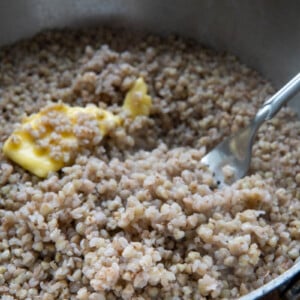
How to Cook Buckwheat Groats (Kasha)
Ingredients
- 1 cup buckwheat groats
- 2 cups boiling water
- 1-2 tablespoon butter, I prefer salted
- ¼ teaspoon sea salt
Instructions
- Boil water in a tea kettle or in a pot.
- Rinse buckwheat groats in a fine mesh strainer, under cold water, until the water is clear. Gently shake the strainer to get as much water out as possible.
- Heat a medium-sized pan over medium heat. Add rinsed and well-drained buckwheat to the pan. Stir with a rubber spatula. Add a tablespoon of butter, and mix with a spatula until the groats are coated. Toast for about 3 to 5 minutes, stirring often.
- When buckwheat groats are golden brown, carefully measure out 2 cups of boiling water and add to the pan. It will sizzle so be extra careful and go slow when pouring, adding one cup at a time.
- Bring it back to a boil, season with salt, lower the heat to low, close the lid, and cook for about 13 min. Turn off the heat and let it sit for 10 min untouched and without removing the lid.
- Remove the lid and fluff with a fork. Per preference, you can add ½ to 1 tbsps of butter and lightly mix it in. You can start with smaller amounts and add as you like or leave the butter out completely.
Notes
- Check if buckwheat is cooked through at around the 10-minute mark. Insert a spatula or fork, If you don't see any liquid on the bottom of the pan - it's good to go. If there is still liquid it might need a few more minutes. Also allowing the buckwheat to stay with a lid for 10 minutes after cooking also allows all the remaining liquid to be absorbed.
- If the buckwheat groats are already toasted, you can skip toasting it in butter and just cover it with boiling water.
- Once cooked, buckwheat will keep in the refrigerator in an airtight container for several days.

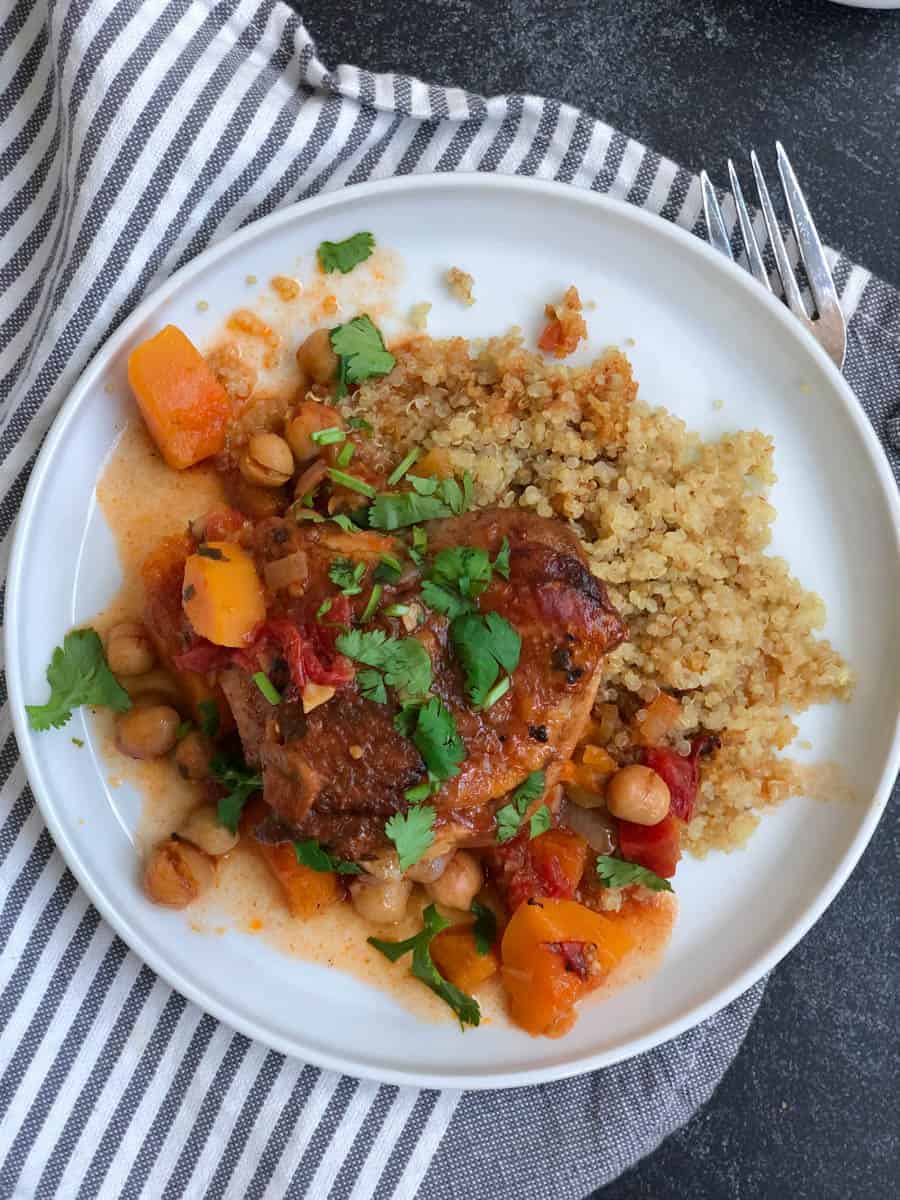




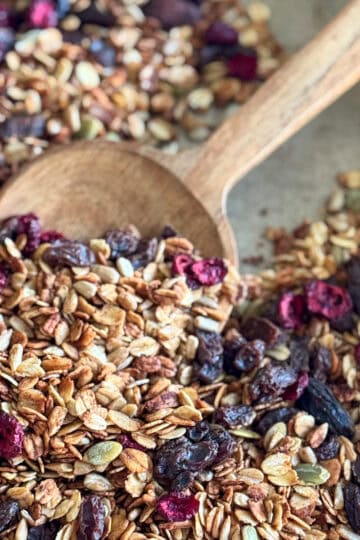
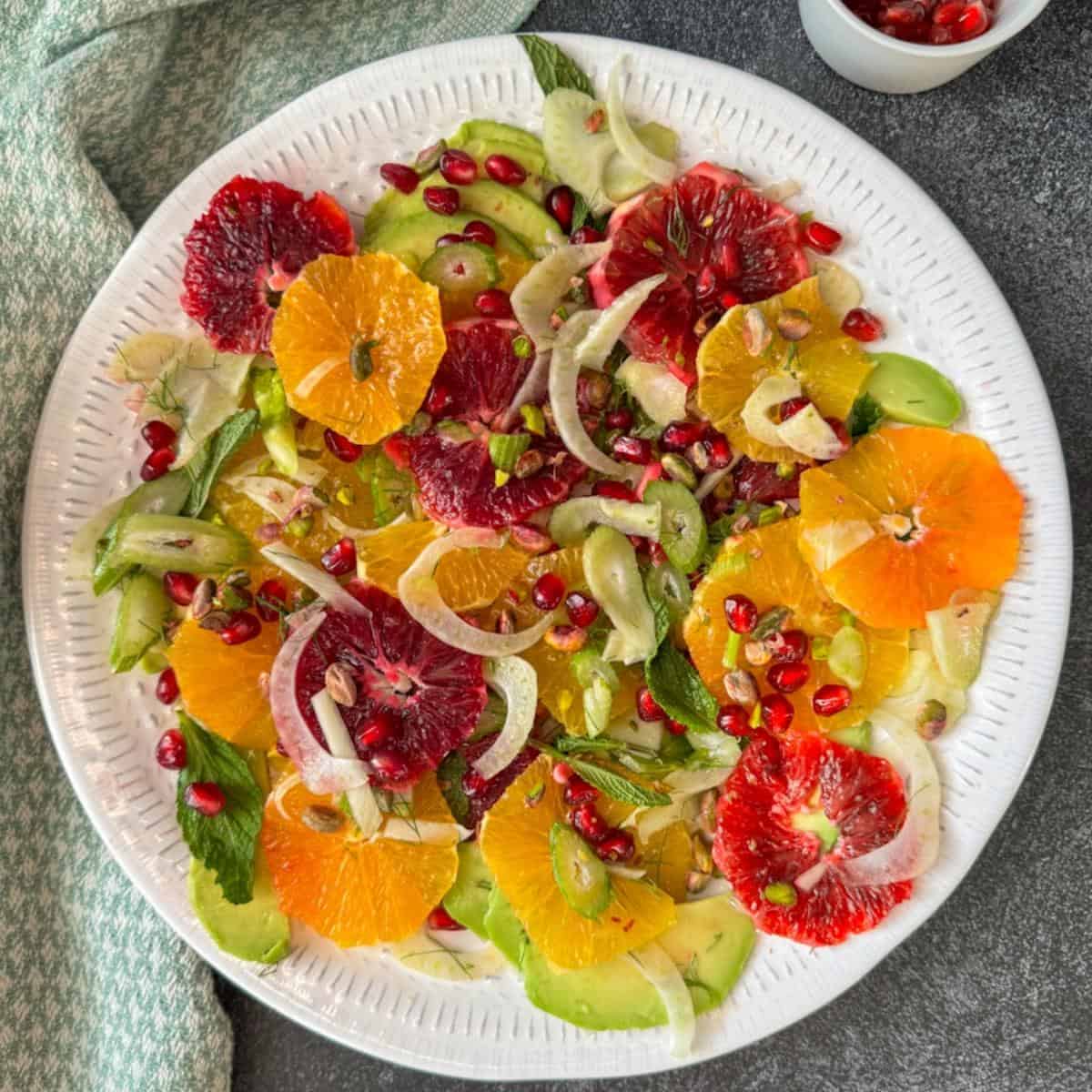
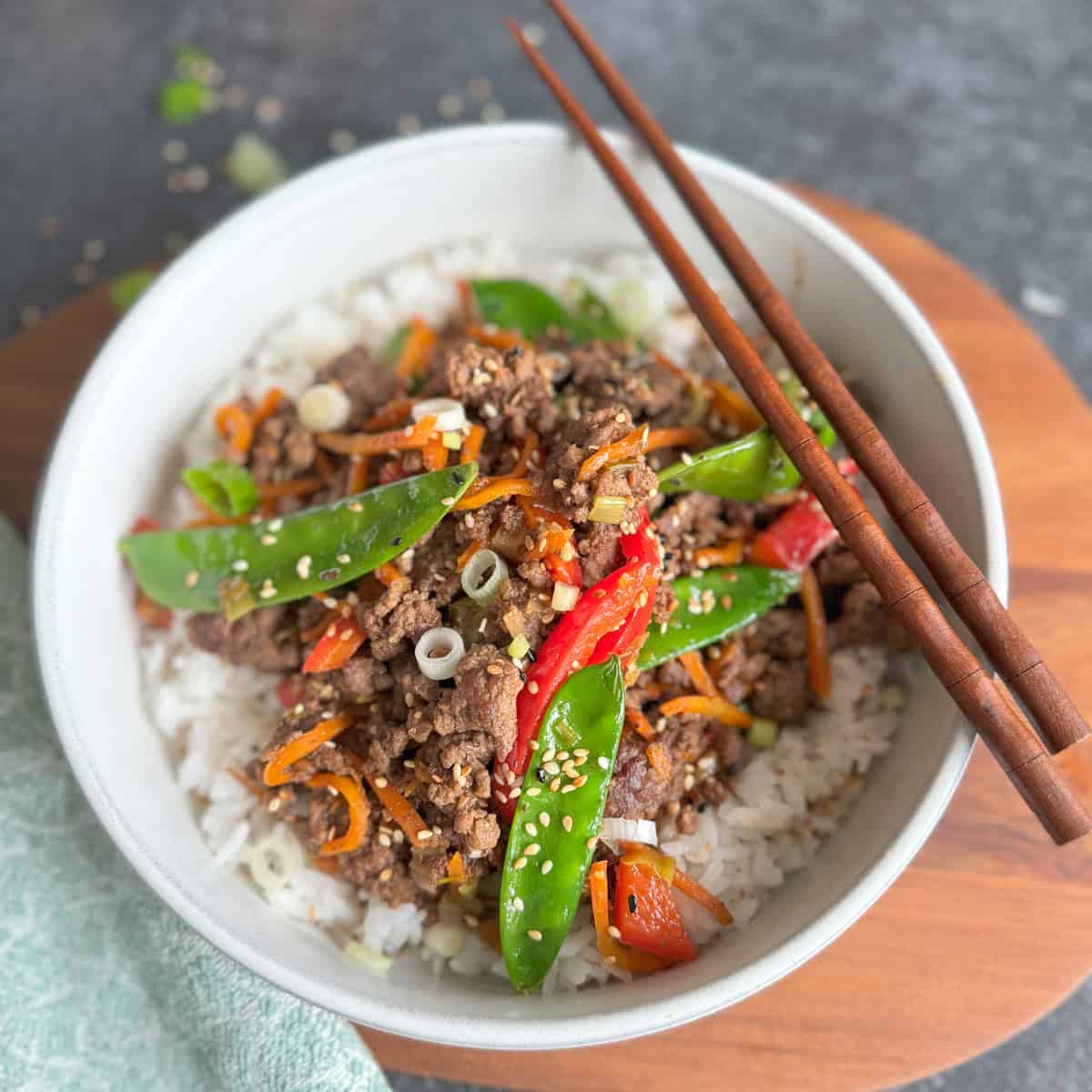
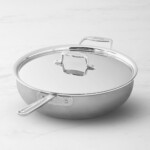


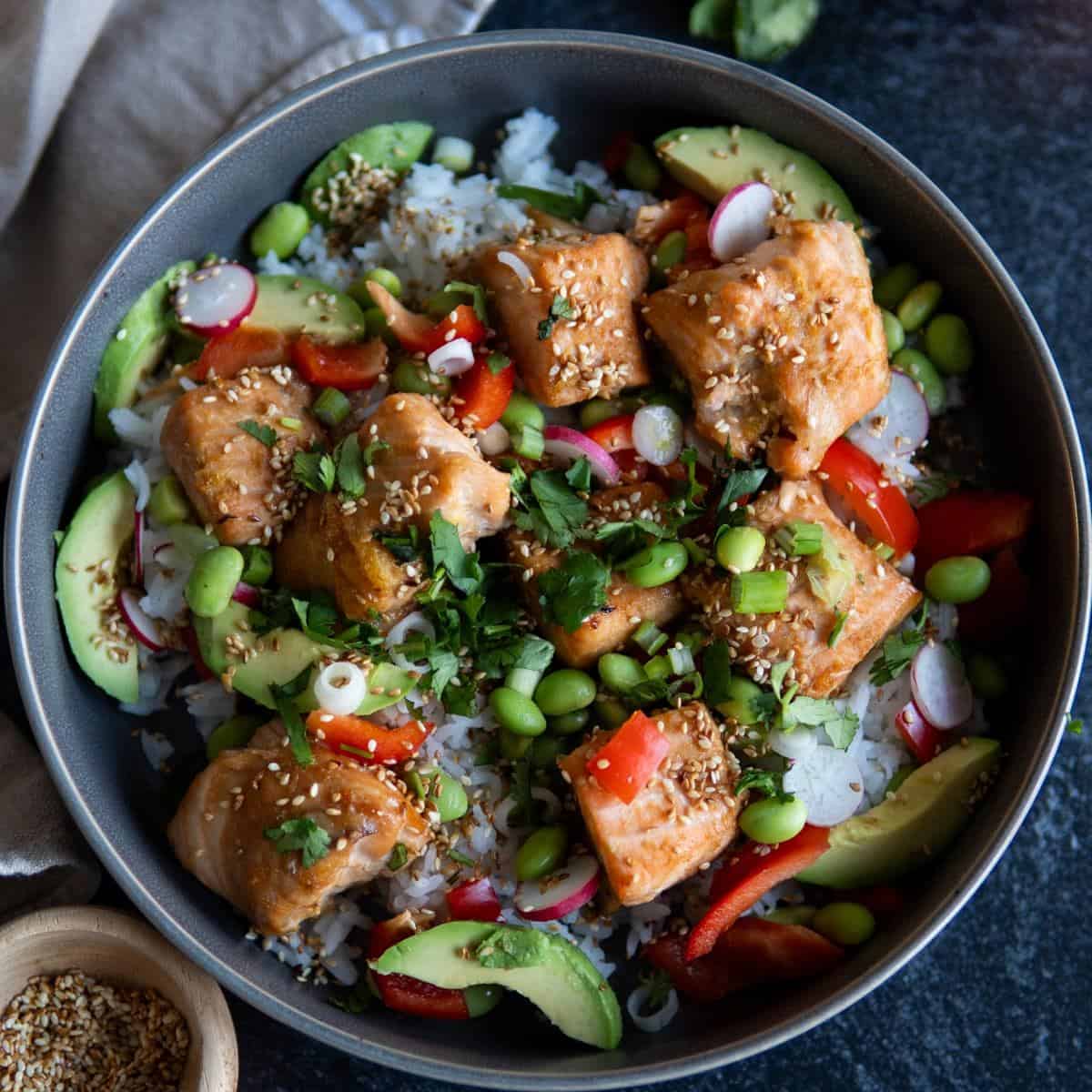
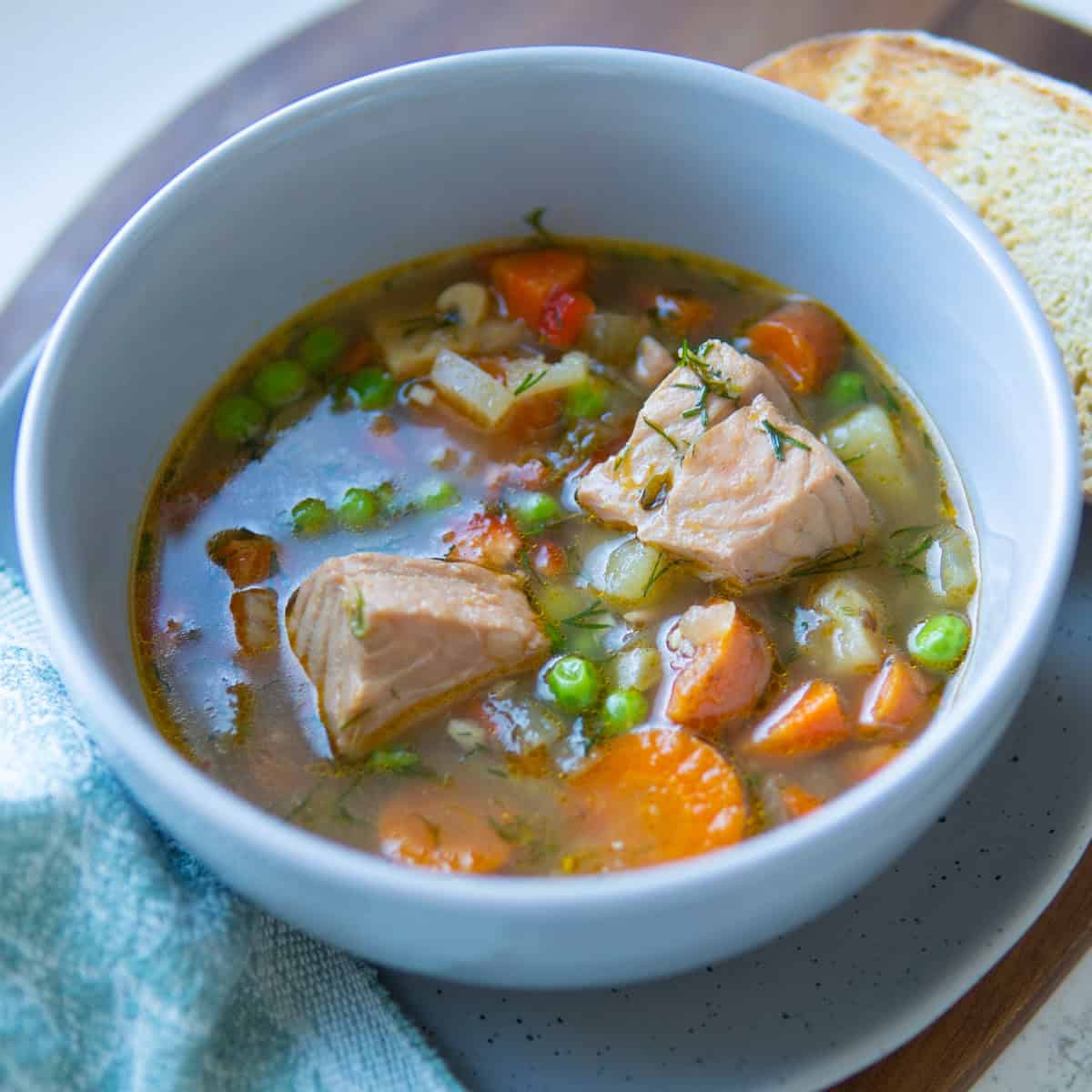
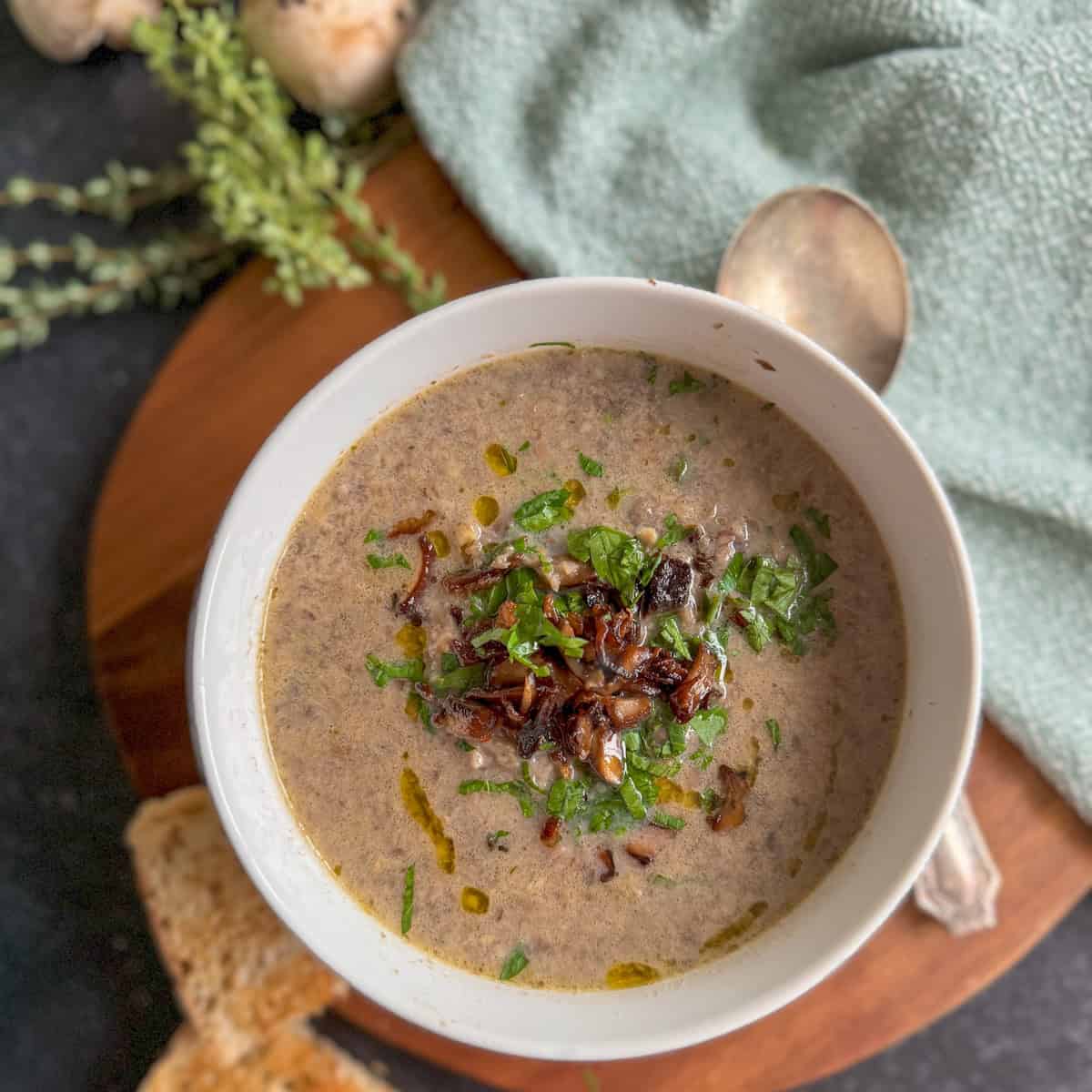
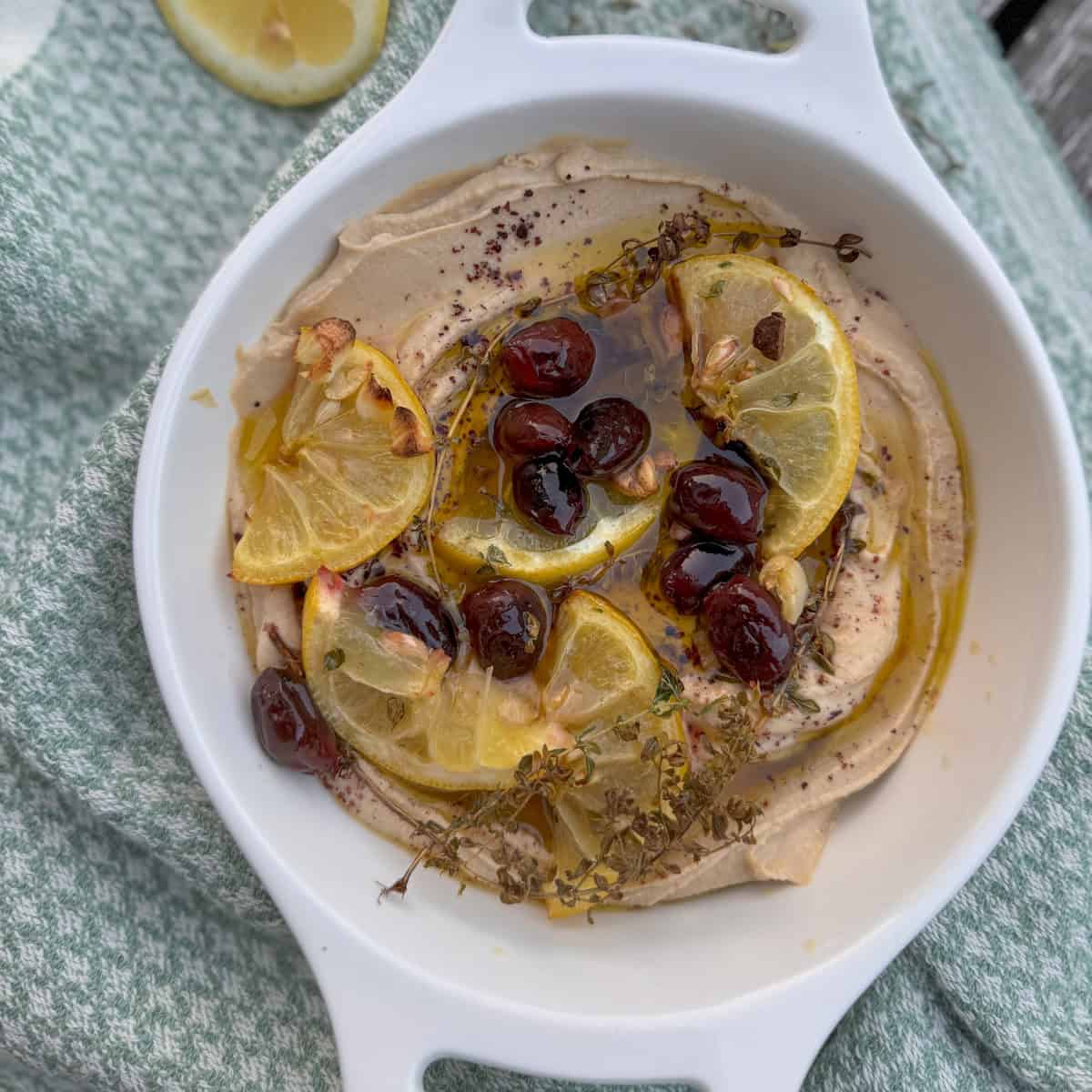
Tessa says
This was simple and delicious.
Tessa says
This was delicious and easy to prepare.
Alla says
Im so glad it worked well for you!